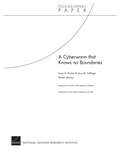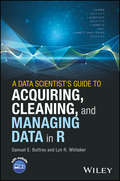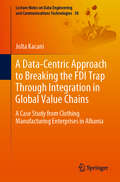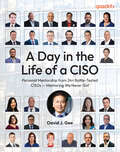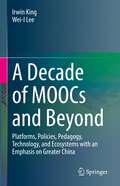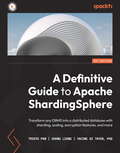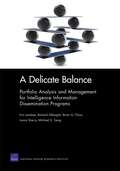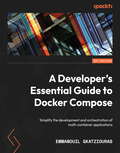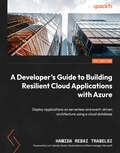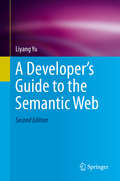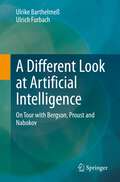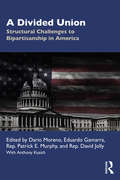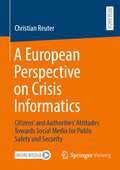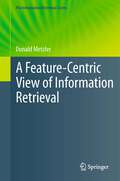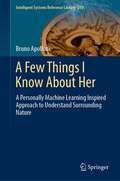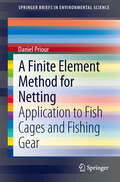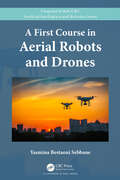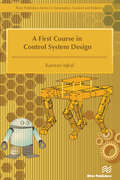- Table View
- List View
A Cyberworm that Knows no Boundaries
by Jerry M. Sollinger Isaac R. Porche III Shawn MckayIt has become clear that Stuxnet-like worms pose a serious threat even to critical U.S. infrastructure and computer systems that are not connected to the Internet. However, defending against such attacks involves complex technological and legal issues. In particular, at the federal level, different organizations have different responsibilities and levels of authority when it comes to investigating or defending against intrusions.
A Data Scientist's Guide to Acquiring, Cleaning, and Managing Data in R
by Samuel E. Buttrey Lyn R. WhitakerThe only how-to guide offering a unified, systemic approach to acquiring, cleaning, and managing data in R Every experienced practitioner knows that preparing data for modeling is a painstaking, time-consuming process. Adding to the difficulty is that most modelers learn the steps involved in cleaning and managing data piecemeal, often on the fly, or they develop their own ad hoc methods. This book helps simplify their task by providing a unified, systematic approach to acquiring, modeling, manipulating, cleaning, and maintaining data in R. Starting with the very basics, data scientists Samuel E. Buttrey and Lyn R. Whitaker walk readers through the entire process. From what data looks like and what it should look like, they progress through all the steps involved in getting data ready for modeling. They describe best practices for acquiring data from numerous sources; explore key issues in data handling, including text/regular expressions, big data, parallel processing, merging, matching, and checking for duplicates; and outline highly efficient and reliable techniques for documenting data and recordkeeping, including audit trails, getting data back out of R, and more. The only single-source guide to R data and its preparation, it describes best practices for acquiring, manipulating, cleaning, and maintaining data Begins with the basics and walks readers through all the steps necessary to get data ready for the modeling process Provides expert guidance on how to document the processes described so that they are reproducible Written by seasoned professionals, it provides both introductory and advanced techniques Features case studies with supporting data and R code, hosted on a companion website A Data Scientist's Guide to Acquiring, Cleaning and Managing Data in R is a valuable working resource/bench manual for practitioners who collect and analyze data, lab scientists and research associates of all levels of experience, and graduate-level data mining students.
A Data-Centric Approach to Breaking the FDI Trap Through Integration in Global Value Chains: A Case Study from Clothing Manufacturing Enterprises in Albania (Lecture Notes on Data Engineering and Communications Technologies #50)
by Jolta KacaniThis book reveals the hidden potential of emerging economies to become the new industrial hubs in existing global value chains. Pursuing a data-centric approach, it investigates the presence of foreign direct investment as an instrument for emerging economies to promote active participation in global value chains. This approach is based on time series analyses conducted at the national and industry level, and on datasets retrieved from international databases such as EORA, ICIO, and World Integrated Solutions. The outcomes of robust statistical models indicate that export-related innovations can improve trade openness and transform emerging economies into active players in global value chains. Researchers, developers, and professionals in the field will find a comprehensive and self-contained guide to the topic.
A Day in the Life of a CISO: Personal Mentorship from 24+ Battle-Tested CISOs — Mentoring We Never Got
by David J. GeeExplore the evolving field of cybersecurity leadership and gain real-world insights from top security leaders on strategy, communication, and resilience to excel as a CISO in today's digital landscapeKey FeaturesGain practical perspectives from global CISOs on cyber transformation, risk management, and career growthExplore AI threats, building resilient teams, cyber strategy, communication skills, and breach recoveryEquip yourself to lead effectively while adapting to evolving cyber challengesPurchase of the print or Kindle book includes a free PDF eBookBook DescriptionAs cyber threats become more complex, effective cybersecurity leadership calls for more than technical expertise; it requires strategic thinking, resilient leadership, and deft communication skills. A Day in the Life of a CISO brings together candid insights from some of the world’s most accomplished CISOs and cybersecurity executives. With invaluable guidance on managing emerging threats, balancing risk and business needs, leading through crisis, and building elite security teams, this book is a practical, real-world guide for professionals looking to elevate their cybersecurity careers or transition into leadership roles. You’ll benefit from the collective wisdom and hard-earned experiences of 29 contributors representing leading organizations worldwide, and learn how to craft cyber strategies, manage vulnerabilities, lead transformations, and develop long-lasting careers in cybersecurity. Whether you are an aspiring CISO, a current security leader, or a business executive seeking a deeper understanding of cybersecurity leadership, this book offers you the knowledge and inspiration to thrive in an increasingly challenging digital world.What you will learnAdapt security strategies to manage emerging threats, including AI-driven risksBuild and execute cyber strategies while balancing business needs and budget constraintsDiscover effective leadership and communication techniques critical for CISOsImplement talent development strategies for building a resilient cybersecurity teamLearn from real-world incidents, including how to recover after breachesExplore career development pathways for cybersecurity professionals, including alternative and non-traditional paths to CISO rolesWho this book is forThis book is for aspiring cybersecurity leaders and managers, as well as current CISOs seeking to sharpen their leadership and strategic skills. IT and risk management professionals transitioning into cybersecurity leadership roles and business executives and board members interested in cybersecurity governance will also find this book useful.
A Decade of MOOCs and Beyond: Platforms, Policies, Pedagogy, Technology, and Ecosystems with an Emphasis on Greater China
by Irwin King Wei-I LeeThis book is an academic publication about the global development of massive open online courses (MOOCs) and major MOOC platforms worldwide in the past decade, as well as the outlook of MOOCs in the future, with an emphasis on Greater China. The book also discusses the upsurge of the demand for online learning and MOOCs during the COVID-19 pandemic.The book is divided into three main parts - Part I: Overview of MOOCs introduces the origin and history of MOOCs and the development of MOOC platforms in Greater China and the global context; Part II: Key Issues discuss the MOOC policies, innovative pedagogy, technology, and ecosystems worldwide; and Part III: Beyond MOOCs probes into the roles and benefits of MOOCs in times of crises, as well as the outlook of MOOCs in the future. In terms of topic diversity, the book contains a comprehensive investigation of the past and latest MOOC developments, extracting and elaborating on relevant information regarding platforms, policies, pedagogy, technology, and ecosystems. Subsequently, in-depth analyses of MOOC data are utilized to deduce the current trends related to the MOOC movement and to extrapolate the likeliest direction of development for MOOCs in the years to come. The book can inform policymakers, education institutions, course instructors, platform developers, investors, researchers, and individual learners of MOOCs about critical information on the present and future of MOOC development, assisting them in making crucial decisions on what initiatives can optimize their advantages in the sector.
A Definitive Guide to Apache ShardingSphere: Transform any DBMS into a distributed database with sharding, scaling, encryption features, and more
by Trista Pan Zhang Liang Yacine Si TayebBecome well versed with all of ShardingSphere's features for every data management need with this comprehensive guide put together by ShardingSphere's founder and core contributorsKey FeaturesUnderstand the core concepts and efficiently set up Apache ShardingSphereEnhance existing databases with sharding, elastic scaling, encryption, governance features, and moreImport and customize the ecosystem's core features for various application scenariosBook DescriptionApache ShardingSphere is a new open source ecosystem for distributed data infrastructures based on pluggability and cloud-native principles that helps enhance your database.This book begins with a quick overview of the main challenges faced by database management systems (DBMSs) in production environments, followed by a brief introduction to the software's kernel concept. After that, using real-world examples of distributed database solutions, elastic scaling, DistSQL, synthetic monitoring, database gateways, and SQL authority and user authentication, you'll fully understand ShardingSphere's architectural components, how they're configured and can be plugged into your existing infrastructure, and how to manage your data and applications. You'll also explore ShardingSphere-JDBC and ShardingSphere-Proxy, the ecosystem's clients, and how they can work either concurrently or independently to address your needs. You'll then learn how to customize the plugin platform to define personalized user strategies and manage multiple configurations seamlessly. Finally, the book enables you to get up and running with functional and performance tests for all scenarios.By the end of this book, you'll be able to build and deploy a customized version of ShardingSphere, addressing the key pain points encountered in your data management infrastructure.What you will learnAssemble a custom solution using the software's pluggable architectureDiscover how to use Database Plus features effectivelyUnderstand the difference between ShardingSphere-JDBC and ShardingSphere-ProxyGet to grips with ShardingSphere's pluggability mechanismExplore mainstream test models for databases and distributed databasesPerform migrations from an on-premise database to a cloud-based databaseReconfigure your data infrastructure and eliminate switching costsWho this book is forThis book is for database administrators working with distributed database solutions who are looking to explore the capabilities of Apache ShardingSphere. DBAs looking for more capable, flexible, and cost-effective alternatives to the solutions they're currently utilizing will also find this book helpful. To get started with this book, a basic understanding of, or even an interest in, databases, relational databases, SQL languages, cloud computing, and data management in general is needed.
A Delicate Balance
by Richard Silberglitt Brian G. Chow Eric Landree Michael S. Tseng Lance SherryThis description of the application of the RAND Corporation's PortMan portfolio analysis and management method and Delphi consensus-building method for the National Security Agency (NSA) Information Sharing Services (ISS) division highlights how these methods enable the data-driven analysis of project portfolios and the allocation of research and development (R&D) and operations and maintenance (O&M) resources according to value, risk, and cost.
A Designer's Log: Case Studies in Instructional Design
by Michael PowerBooks and articles on instructional design in online learning abound but rarely do we get such a comprehensive picture of what instructional designers do, how they do it, and the problems they solve as their university changes. Power documents the emergence of an adapted instructional design model for transforming courses from single-mode to dual-mode instruction, making this designer’s log a unique contribution to the field of online learning.
A Developer's Essential Guide to Docker Compose: Simplify the development and orchestration of multi-container applications
by Emmanouil GkatziourasStart defining your infrastructure using Docker Compose and leverage it for everyday development or deploymentKey FeaturesDistribute your code in an easier way for developers to get startedSet up complex infrastructure for development and CI/CD purposesDeploy simple multi-container applications using Docker ComposeBook DescriptionSoftware development is becoming increasingly complex due to the various software components used. Applications need to be packaged with software components to facilitate their operations, making it complicated to run them. With Docker Compose, a single command can set up your application and the needed dependencies. This book starts with an overview of Docker Compose and its usage and then shows how to create an application. You will also get to grips with the fundamentals of Docker volumes and network, along with Compose commands, their purpose, and use cases. Next, you will set up databases for daily usage using Compose and, leveraging Docker networking, you will establish communication between microservices. You will also run entire stacks locally on Compose, simulate production environments, and enhance CI/CD jobs using Docker Compose. Later chapters will show you how to benefit from Docker Compose for production deployments, provision infrastructure on public clouds such as AWS and Azure, and wrap up with Compose deployments on said infrastructure. By the end of this book, you will have learned how to effectively utilize Docker Compose for day-to-day development.What you will learnCreate multi-container applications using Docker ComposeUse Docker Compose for daily developmentConnect microservices leveraging Docker network fundamentalsAdd monitoring to services leveraging PrometheusDeploy to production using Docker ComposeTranslate Compose files to Kubernetes deploymentsWho this book is forThis book is for software engineers, developer advocates, and DevOps engineers looking to set up multi-container Docker applications using Compose without the need to set up a Docker orchestration engine. It is also for team leads looking to increase the productivity of an organization's software teams by streamlining the provisioning of complex development environments locally using Docker Compose. Readers are expected to understand containerization and must possess fundamental Docker knowledge to get started with this book.
A Developer's Guide to Building Resilient Cloud Applications with Azure: Deploy applications on serverless and event-driven architecture using a cloud database
by Lori Lalonde Hamida Rebai TrabelsiSuccessfully modernize your apps on Azure using APIs, event-driven systems, functions, and Service Fabric and connect them to different relational and non-relational databasesPurchase of the print or Kindle book includes a free PDF eBookKey FeaturesUnderstand Function-as-a-Service and Azure Service Fabric for distributed applicationsDevelop event-based and message-based solutions using Event Grid and Azure Event HubsExplore continuous deployment for Docker with Azure DevOps and integrate Docker Hub with CI/CD pipelinesBook DescriptionTo deliver software at a faster rate and reduced costs, companies with stable legacy systems and growing data volumes are trying to modernize their applications and accelerate innovation, but this is no easy matter. A Developer's Guide to Building Resilient Cloud Applications with Azure helps you overcome these application modernization challenges to build secure and reliable cloud-based applications on Azure and connect them to databases with the help of easy-to-follow examples.The book begins with a basic definition of serverless and event-driven architecture and Database-as-a-Service, before moving on to an exploration of the different services in Azure, namely Azure APIManagement using the gateway pattern, event-driven architecture, Event Grid, Azure Event Hubs, Azure message queues, FaaS using Azure Functions, and the database-oriented cloud. Throughout the chapters, you'll learn about creating, importing, and managing APIs and Service Fabric in Azure, and discover how to ensure continuous integration and deployment in Azure to fully automate the software delivery process, that is, the build and release process.By the end of this book, you'll be able to build and deploy cloud-oriented applications using APIs, serverless, Service Fabric, Azure Functions, and Event Grid technologies.What you will learnUnderstand the architecture of Azure Functions and Azure Service FabricExplore Platform-as-a-Service options for deploying SQL Server in AzureCreate and manage Azure Storage and Azure Cosmos DB resourcesLeverage big data storage in Azure servicesSelect Azure services to deploy according to a specific scenarioSet up CI/CD pipelines to deploy container applications on Azure DevOpsGet to grips with API gateway patterns and Azure API ManagementWho this book is forThis book is for cloud developers, software architects, system administrators, database administrators, data engineers, developers, and computer science students who want to understand the role of the software architect or developer in the cloud world. Professionals looking to enhance their cloud and cloud-native programming concepts on Azure will also find this book useful. A solid background in C#, ASP.NET Core, and any recent version of Visual Studio and basic knowledge of cloud computing, Microsoft Azure, and databases will be helpful when using this book.
A Developer's Guide to Cloud Apps Using Microsoft Azure: Migrate and modernize your cloud-native applications with containers on Azure using real-world case studies
by Hamida Rebai Trabelsi Marc-Andre LanielBuild and deploy modern and secure applications on Microsoft Azure by implementing best practices, patterns, and new technologies with this easy-to-follow guidePurchase of the print or Kindle book includes a free PDF eBookKey FeaturesLearn various methods to migrate legacy applications to cloud using different Azure servicesImplement continuous integration and deployment as a best practice for DevOps and agile developmentGet started with building cloud-based applications using containers and orchestrators in different scenariosBook DescriptionCompanies face several challenges during cloud adoption, with developers and architects needing to migrate legacy applications and build cloud-oriented applications using Azure-based technologies in different environments. A Developer's Guide to Cloud Apps Using Microsoft Azure helps you learn how to migrate old apps to Azure using the Cloud Adoption Framework and presents use cases, as well as build market-ready secure and reliable applications.The book begins by introducing you to the benefits of moving legacy apps to the cloud and modernizing existing ones using a set of new technologies and approaches. You'll then learn how to use technologies and patterns to build cloud-oriented applications. This app development book takes you on a journey through three major services in Azure, namely Azure Container Registry, Azure Container Instances, and Azure Kubernetes Service, which will help you build and deploy an application based on microservices. Finally, you'll be able to implement continuous integration and deployment in Azure to fully automate the software delivery process, including the build and release processes.By the end of this book, you'll be able to perform application migration assessment and planning, select the right Azure services, and create and implement a new cloud-oriented application using Azure containers and orchestrators.What you will learnGet to grips with new patterns and technologies used for cloud-native applicationsMigrate old applications and databases to Azure with easeWork with containers and orchestrators to automate app deploymentSelect the right Azure service for deployment as per the use casesSet up CI/CD pipelines to deploy apps and services on Azure DevOpsLeverage Azure App Service to deploy your first applicationBuild a containerized app using Docker and Azure Container RegistryWho this book is forThis book is for cloud developers, software architects, system administrators, developers, and computer science students looking to understand the new role of the software architect or developer in the cloud world. Professionals looking to enhance their cloud and cloud-native programming concepts will also find this book useful. A sound background in C#, ASP.NET Core, and Visual Studio (any recent version) and basic knowledge of cloud computing will be helpful.
A Developer’s Guide to the Semantic Web
by Liyang YuCovering the theory, technical components and applications of the Semantic Web, this book's unrivalled coverage includes the latest on W3C standards such as OWL 2, and discusses new projects such as DBpedia. It also shows how to put theory into practice.
A Different Look at Artificial Intelligence: On Tour with Bergson, Proust and Nabokov
by Ulrich Furbach Ulrike BarthelmeßDigitalization is inexorably conquering our lives - also with artificial intelligence (AI) methods. Search engine operators, social network operators and shipping platform operators know more and more about us, about our buying and living habits. User data has become a valuable commodity. We live and work with computer systems that behave intelligently or are even intelligent. Questions like "Can machines be intelligent?" or "Can they have emotions or a consciousness?" keep popping up. To enable readers to form their own opinion on these questions, the authors clearly explain individual techniques or methods of AI and relate them to approaches from philosophy, art and neurobiology. Topics such as logical reasoning, knowledge and memory play just as important a role as machine learning and artificial neural networks. In the foreground is the question of what constitutes memory and thinking, what role our emotions play when we as humans move through life, through the world. A book that offers unusual perspectives on artificial intelligence.
A Distributed Linear Programming Models in a Smart Grid (Power Electronics and Power Systems)
by Prakash Ranganathan Kendall E. NygardThis book showcases the strengths of Linear Programming models for Cyber Physical Systems (CPS), such as the Smart Grids. Cyber-Physical Systems (CPS) consist of computational components interconnected by computer networks that monitor and control switched physical entities interconnected by physical infrastructures. A fundamental challenge in the design and analysis of CPS is the lack of understanding in formulating constraints for complex networks. We address this challenge by employing collection of Linear programming solvers that models the constraints of sub-systems and micro grids in a distributed fashion. The book can be treated as a useful resource to adaptively schedule resource transfers between nodes in a smart power grid. In addition, the feasibility conditions and constraints outlined in the book will enable in reaching optimal values that can help maintain the stability of both the computer network and the physical systems. It details the collection of optimization methods that are reliable for electric-utilities to use for resource scheduling, and optimizing their existing systems or sub-systems. The authors answer to key questions on ways to optimally allocate resources during outages, and contingency cases (e. g. , line failures, and/or circuit breaker failures), how to design de-centralized methods for carrying out tasks using decomposition models; and how to quantify un-certainty and make decisions in the event of grid failures.
A Divided Union: Structural Challenges to Bipartisanship in America
by Dario Moreno, Eduardo Gamarra, Rep. Patrick E. Murphy, and Rep. David JollyA Divided Union delves deep into ten pressing political challenges that former US Representatives Patrick Murphy (D) and David Jolly (R) have identified over their multiple terms in Congress and that continue to plague the American electorate today. In an introduction describing their unique paths to Congress, Murphy and Jolly focus in detail on key institutional barriers they faced in Washington in attempting to do the job voters elected them to do. They introduce us to geographic challenges, demographic change, a polarized media, gerrymandering, the role of money in politics, the structure of primary elections, and several other aspects of political life on Capitol Hill. The core of the book is original analysis by experts who tackle these topics in a manner relevant to both the seasoned political science student as well as the general reader. From the commercials we see on TV to the city council districts in which we live, these concerns shape every facet of our public lives and are distilled here in a careful synthesis of years of experience and research. Contributors include former federal elected officials, political science professors, members of the press, and scholars immersed in their fields of study. While other textbooks may examine similar issues, few have been edited by former members of the U.S. House who have walked the halls of Congress and directly experienced political dysfunction at so many levels – and are willing to address it. A Divided Union is appropriate for all political science students as well as the general public frustrated and alarmed by political gridlock.
A European Perspective on Crisis Informatics: Citizens’ and Authorities’ Attitudes Towards Social Media for Public Safety and Security
by Christian ReuterMobilising helpers in the event of a flood or letting friends know that you are okay in the event of a terrorist attack – more and more people are using social media in emergency, crisis or disaster situations. Storms, floods, attacks or pandemics (esp. COVID-19) show that citizens use social media to inform themselves or to coordinate. This book presents qualitative and quantitative studies on the attitudes of emergency services and citizens in Europe towards social media in emergencies. Across the individual sub-studies, almost 10,000 people are surveyed including representative studies in the Netherlands, Germany, the UK and Italy. The work empirically shows that social media is increasingly important for emergency services, both for prevention and during crises; that private use of social media is a driving force in shaping opinions for organisational use; and that citizens have high expectations towards authorities, especially monitoring social media is expected, and sometimes responses within one hour. Depending on the risk culture, the data show further differences, e.g. whether the state (Germany) or the individual (Netherlands) is seen as primarily responsible for coping with the situation.
A Fashion Retailer’s Guide to Thriving in Turbulent Times
by Ghalia Boustani Daniela LeoniniBy raising questions and providing scenarios for success, this book embraces fashion brand development in current turbulent retail environments. A brand must have an essence; it needs to respect a philosophy, abide by values and follow clear processes. A brand’s success and sustainability follow specific rules, nonetheless for fashion brands. But do fashion brand management rules apply in today’s turbulent times? Acknowledging and going beyond branding theory, this book challenges knowledge and practices that have been guiding fashion retail brands for many years. Co-written by an academic researcher and a retail consultant with 30 years of experience, this practical guide offers not a process that fashion brands must follow, but potential avenues for survival in today’s retail market and facing today’s customers. Professionals and students of fashion retailing and branding will appreciate the detailed case studies that illustrate revisited concepts and thought-provoking suggestions on how to make decisions for an uncertain future.
A Feature-Centric View of Information Retrieval (The Information Retrieval Series #27)
by Donald MetzlerCommercial Web search engines such as Google, Yahoo, and Bing are used every day by millions of people across the globe. With their ever-growing refinement and usage, it has become increasingly difficult for academic researchers to keep up with the collection sizes and other critical research issues related to Web search, which has created a divide between the information retrieval research being done within academia and industry. Such large collections pose a new set of challenges for information retrieval researchers. In this work, Metzler describes highly effective information retrieval models for both smaller, classical data sets, and larger Web collections. In a shift away from heuristic, hand-tuned ranking functions and complex probabilistic models, he presents feature-based retrieval models. The Markov random field model he details goes beyond the traditional yet ill-suited bag of words assumption in two ways. First, the model can easily exploit various types of dependencies that exist between query terms, eliminating the term independence assumption that often accompanies bag of words models. Second, arbitrary textual or non-textual features can be used within the model. As he shows, combining term dependencies and arbitrary features results in a very robust, powerful retrieval model. In addition, he describes several extensions, such as an automatic feature selection algorithm and a query expansion framework. The resulting model and extensions provide a flexible framework for highly effective retrieval across a wide range of tasks and data sets. A Feature-Centric View of Information Retrieval provides graduate students, as well as academic and industrial researchers in the fields of information retrieval and Web search with a modern perspective on information retrieval modeling and Web searches.
A Few Things I Know About Her: A Personally Machine Learning Inspired Approach to Understand Surrounding Nature (Intelligent Systems Reference Library #219)
by Bruno ApolloniThis book reconsiders key issues, such as description and explanation, which affect data analytics. For starters: the soul does not exist. Once released from this cumbersome roommate, we are left with complex biological systems: namely, ourselves, who must configure their environment in terms of worlds that are compatible with what they sense. Far from supplying yet another cosmogony, the book provides the cultivated reader with computational tools for describing and understanding data arising from his surroundings, such as climate parameters or stock market trends, even the win/defeat story of his son football team. Besides the superposition of the very many universes considered by quantum mechanics, we aim to manage families of worlds that may have generated those data through the key feature of their compatibility. Starting from a sharp engineering of ourselves in term of pairs consisting of genome plus a neuron ensemble, we toss this feature in different cognitive frameworks within a span of exploitations ranging from probability distributions to the latest implementations of machine learning. From the perspective of human society as an ensemble of the above pairs, the book also provides scientific tools for analyzing the benefits and drawbacks of the modern paradigm of the world as a service.
A Field Guide to Digital Color
by Maureen StoneMaureen Stone's field guide to digital color presents a survey of digital color with special emphasis on those fields important for computer graphics. The book provides the foundation for understanding color and its applications, discusses color media and color management and the use of color in computer graphics, including color design and selecti
A Finite Element Method for Netting: Application to fish cages and fishing gear (SpringerBriefs in Environmental Science)
by Daniel PriourThis book fully describes a finite element method for netting. That describes the relation between forces and deformation of the netting. That takes into account forces due to the twine elasticity, the hydrodynamic forces, the catch effect, the mesh opening stiffness. This book is divided in 5 parts. The first section contains introduction on the finite element method, the second part is about equilibrium calculation, the third presents a triangular element for netting, the fourth and fifth are for cable and node element. The sixth presents few validation cases.
A Fintech em um Flash
by Fernanda Belokurows Agustin RubiniFinalmente um guia explicativo de tecnologia financeira! A indústria de tecnologia de serviços financeiros está crescendo, com investimentos superiores a US$20 bilhões só no ano passado. Existem mais de 5000 startups de fintech operando e 50 delas já alcançaram uma avaliação de bilhões de dólares. O alcance deste mercado vai até os pagamentos online. A tecnologia financeira promete mudar a forma como gerimos o nosso dinheiro online, quebrando barreiras no cenário do setor de serviços financeiros. Compreender suas muitas facetas é a chave para nadar nas águas das nuances complexas desta indústria global. O livro “A Fintech em um Flash” é o seu guia explicativo sobre o futuro do setor bancário e de seguros. O livro pretende identificar os conceitos-chave de forma a ajudá-lo a entender todos os aspectos, a fim de que você possa aproveitar essas novas tecnologias. Dentro, você encontrará uma série de tópicos interessantes, como pagamentos online, financiamento coletivo, bancos challengers, seguros online, empréstimos digitais, Big Data e comércio eletrônico. Isso irá fazer você repensar a maneira como administra o seu dinheiro online e até mesmo encontrar novas formas de realizar pagamentos online. Abrangente, organizado e detalhado, este guia é a sua fonte de acesso para tudo o que você precisa para navegar com confiança neste cenário em constante mudança desta indústria em expansão.
A First Course in Aerial Robots and Drones (Chapman & Hall/CRC Artificial Intelligence and Robotics Series)
by Yasmina Bestaoui SebbaneA First Course in Aerial Robots and Drones provides an accessible and student friendly introduction to aerial robots and drones. Drones figure prominently as opportunities for students to learn various aspects of aerospace engineering and design. Drones offer an enticing entry point for STEM studies. As the use of drones in STEM studies grows, there is an emerging generation of drone pilots who are not just good at flying, but experts in specific niches, such as mapping or thermography. Key Features: Focuses on algorithms that are currently used to solve diverse problems. Enables students to solve problems and improve their science skills. Introduces difficult concepts with simple, accessible examples. Suitable for undergraduate students, this textbook provides students and other readers with methods for solving problems and improving their science skills.
A First Course in Control System Design
by Kamran IqbalControl systems are pervasive in our lives. Our homes have environmental controls. The appliances we use at home, such as the washing machine, microwave, etc. have embedded controllers. We fly in airplanes and drive automobiles, which make extensive use of control systems. The increasing automation in the past few decades has increased our reliance on control systems.A First Course in Control System Design discusses control systems design from a model-based perspective as applicable to single-input single-output systems. The emphasis in this book is on understanding and applying the techniques that enable the design of effective control systems. The book covers the time-domain and the frequency-domain design methods, as well as the design of continuous-time and discrete-time systems.Technical topics discussed in the book include: Modeling of physical systems Analysis of transfer function and state variable models Control system design via root locus Control system design in the state-space Control design of sampled-data systems Compensator design via frequency response modification
A First Course in Electrical and Computer Engineering
by Louis ScharfElectrical and computer engineering textbook
